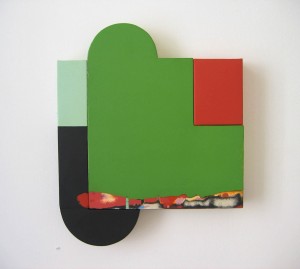
When canvas is as important as the painting
By Kenneth Baker
When the term “shaped canvas” came into use, it meant a painting surface eccentric enough to call attention to itself, as the traditional pictorial rectangle does not. Formalist critics briefly saw the shaped canvas as painting’s salvation. It permitted painters breakout artistic moves that would not scuttle art completely, as offspring of Dada, such as Fluxus, threatened to do.
The delectable work of Bay Area painter Cornelia Schulz at Patricia Sweetow shows the shaped canvas smoothly in use as a tool of thought about color and structure.
The implicit pictorial rectangle seems to undergird Schulz’s abstractions to about the degree it still conditions our expectations of new painting. Such attunements occur only in the work of an artist of mature intuition.
The felt confidence of Schulz’s new pieces puts a viewer at ease even before any sorting of their lyrical niceties begins.
The paintings look like products of design: small, interlocked canvas elements, stretched individually, clearly required planning, as did the stretched canvas semicircles that pull at the pictures’ perimeters here and there.
But how much repainting did it take to achieve the perfect balance of sap green, turquoise and deep red in “Down the Line, or Don’t Worry About It” (2003)? At what point in making the picture did Schulz decide to let the mottled margin of sanded-down color show, like distant weather, along its base? No telling.
Their resistance to analysis makes the paintings’ consistent, unformulaic resolution all the more satisfying.
Confidence also crackles through the big charcoal and graphite drawings – – but not the paintings — of Frederick Hayes at Sweetow.
Hayes pictures brutalist skyscrapers, shadowed by gnarly clouds that look like comic-strip thought balloons of mum malfeasance.